Tank truck testing – Basically for facilities in the DMNFR that want to do the method 27 testing year-round, those facilities have to demonstrate that they can capture the emissions.
Facilities are not required to adopt these emissions controls however if they do not, they don’t have the option of performing the Method 27 tests during the summer in the DMNFR.
The Division is proposing to expand the gasoline tank truck testing provisions to encourage the use of emission controls and support year-round testing. The current testing provisions in Regulation Number 7 limit testing to October through April and are based on EPA’s CTGs, in particular the Control of Volatile Organic Compound Leaks from Gasoline Tank Trucks and Vapor Collection Systems (1978), and require testing in accordance with EPA’s Method 27. Neither EPA’s CTGs nor Method 27 limit the calendar time during which testing must occur but both direct that gasoline vapors be purged from the gasoline tank truck before conducting the leak-tightness test to avoid residual gasoline vapors causing testing inconsistencies. However, because these provisions are in Colorado’s SIP, Colorado must demonstrate that revising the provisions will not cause an interference with Colorado’s ability to attain or maintain the NAAQS. See CAA § 110(l).
The Division estimates uncontrolled emissions from the testing of 1,800 gasoline tank trucks at 80 tpy. Currently, there are four testing facilities located in the DM/NFR, four located outside the DM/NFR, and two remote testing facilities. Controlling the purged vapors that occur as part of the testing procedure would result in an emissions reduction of 76 tpy, if all testing facilities chose the proposed testing schedule option.
Because testing does not currently occur in the DM/NFR between May and September, the Division cannot say what portion of those controlled emissions may occur during the summer months. However, the Division is also proposing that testing facility operators must also control vapor purge emissions that occur for other reasons, such as gasoline tank truck repair, to be able to conduct gasoline tank truck testing year-round, which would result in additional controlled emissions reductions. Therefore, the Division’s proposed revisions to allow year-round testing so long as the testing facility operator controls all vapor purge emissions from testing or other purging will reduce emissions and will not interfere with attainment or maintenance of the NAAQS.



